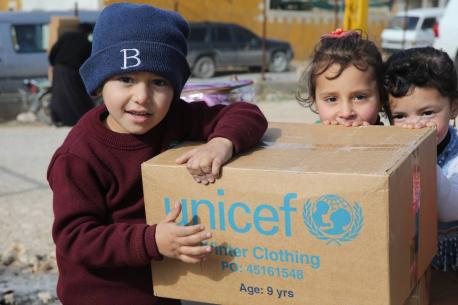
Global Examples of Humanitarian Aid from UNICEF
With a presence in over 190 countries and territories, UNICEF can get humanitarian aid to children living in the world's most remote places.
UNICEF has helped save more children's lives than any other humanitarian organization. What makes UNICEF unique is an extensive network that means it can get help quickly to where it’s needed most. UNICEF can ship lifesaving supplies almost anywhere in the world within 48-72 hours from its humanitarian warehouse in Copenhagen — the largest in the world — or from one of its regional supply hubs. With a presence in more than 190 countries and territories, UNICEF can be on the ground quickly when emergencies hit, providing humanitarian aid supplies and services. And once the immediate crisis has passed, UNICEF remains to help build more resilient communities, reduce long-term reliance on relief and lay the foundations for sustainable development.
UNICEF won’t stop until every child not only survives, but thrives, offering lifesaving relief through:
- Emergency response services
- Prevention and treatment of all forms of malnutrition, including severe acute malnutrition, which can prove fatal
- Immunization of the world's children against measles, polio, neo-natal tetanus
- Providing safe water for drinking, cooking and personal hygiene
- Protection for children and psychosocial support for children and caregivers
- Cash transfers so families can provide for themselves and give their children what they need to learn and grow, healthy, happy and safe
UNICEF's global humanitarian aid efforts
The COVID-19 pandemic has triggered an unprecedented global health, humanitarian, socio-economic and human rights crisis, exacerbating the vulnerabilities of affected children. UNICEF is working hard to address the setbacks to children’s care that have occurred during the pandemic and help those who are struggling to survive in some of the world’s toughest places:
- Central Sahel crisis: Across the Central Sahel, over 10 million people are in need of humanitarian assistance due to insecurity, forced displacement, lack of access to basic services and COVID-19’s socio-economic impacts.
- Protracted conflicts in the Syrian Arab Republic and Yemen: Following a decade of conflict and humanitarian crisis, violence in Syria continues to intensify, and over 10 million people inside the country require humanitarian assistance. The flight of Syrians to neighboring countries has created the largest displacement crisis in the world, with over 5 million registered refugees in Egypt, Iraq, Jordan, Lebanon and Turkey. After more than five years of conflict in Yemen, 80 percent of the population — over 24 million — require humanitarian assistance.
- Afghanistan, Somalia and South Sudan: Globally, protracted humanitarian crises have become increasingly common. In Afghanistan, the number of people in need of humanitarian assistance increased drastically from 2019 to 2020. In Somalia, conflict continues to disrupt the lives of children and increase their vulnerability to protection violations. And in South Sudan, the population is struggling under the cumulative effects of years of prolonged conflict, chronic vulnerabilities and weak essential services.
HOW TO HELP
There are many ways to make a difference
War, famine, poverty, natural disasters — threats to the world's children keep coming. But UNICEF won't stop working to keep children healthy and safe.
UNICEF works in over 190 countries and territories — more places than any other children's organization. UNICEF has the world's largest humanitarian warehouse and, when disaster strikes, can get supplies almost anywhere within 72 hours. Constantly innovating, always advocating for a better world for children, UNICEF works to ensure that every child can grow up healthy, educated, protected and respected.
Would you like to help give all children the opportunity to reach their full potential? There are many ways to get involved.



